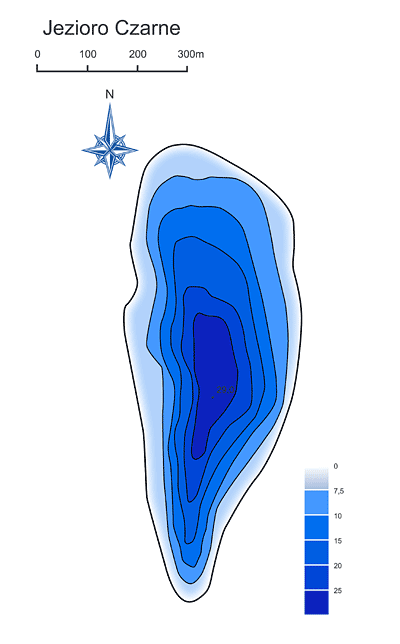Czarne Lake
 One of the most beautiful Drawa Wilderness lakes (19,48ha, 29m deep), located south from the Ostrowiec settlement. It is completely surrounded by woods. It fills a no-outlet land depression that came into being around 10 thousand years ago as a dead glacier melted itself. The basin has steep slopes and the bottom has a steep depression. The water’s colour is sapphire – characteristic to stone-wart lakes – and visible especially from up-high.
One of the most beautiful Drawa Wilderness lakes (19,48ha, 29m deep), located south from the Ostrowiec settlement. It is completely surrounded by woods. It fills a no-outlet land depression that came into being around 10 thousand years ago as a dead glacier melted itself. The basin has steep slopes and the bottom has a steep depression. The water’s colour is sapphire – characteristic to stone-wart lakes – and visible especially from up-high.
The lake is famous for very clean water that’s translucent down to 7m deep (on average). This lake is hydrologically and ecologically unique. Its great depth causes the waters to never be stirred by the wind all the way to the bottom. This phenomenon, unique in Poland, causes Czarne to be a meromictic lake. The layer of fertile water beneath 13m deep has remained stable for years. Those deep water layers, for not having any contact with surface water, are devoid of oxygen. Therefore, there are no animals living there. The bottom is inhabited by anaerobic bacteria called Desulfovibrio desulfuricans that produce sulphurated hydrogen which saturates the lowest layers of water. Another, uniquely scarlet, bacteria that lives here is Cromatium okenii which oxidize sulphuretted hydrogen to free the sulphur. The upper layers of water are stirred by the winds in the spring and autumn, therefore the water there is oxidized. They are mesotrophic in character. They are home to a rare in the Pomeranian lakes lavaret. It is possible that lavaret is natural to this lake rather than artificially introduced, as in many other lakes. The near-coast part of the lake’s bottom is inhabited by stone-wart, as well, as patches of the rare sea naiad, and mud horned pond-weed. Somewhat deeper places have developed communities of spring-wart. Before the founding of a national park here, there were plans to establish a nature reserve here.
Another peculiarity of this lake are its water outlets. In the south, there is a tiny pond supplied with water by a stream seeping from Czarne. The pond’s waters, in turn, seep into the earth, and flow to the deeper water-bearing layers, thus making the pond a swallow-hole.
The lake is also strikingly dynamic with its ever-rising water level in recent years. Hydrologists and ecologists predict that Lake Czarne and the phenomena connected to it constitute for a rarity on the national scale and still hides many unresolved mysteries.
A blue hiking trail from Jagoda to Ostrowiec runs along the eastern bank of Czarne. The swallow-hole at the southern edge of the lake is visible from the trail.
















